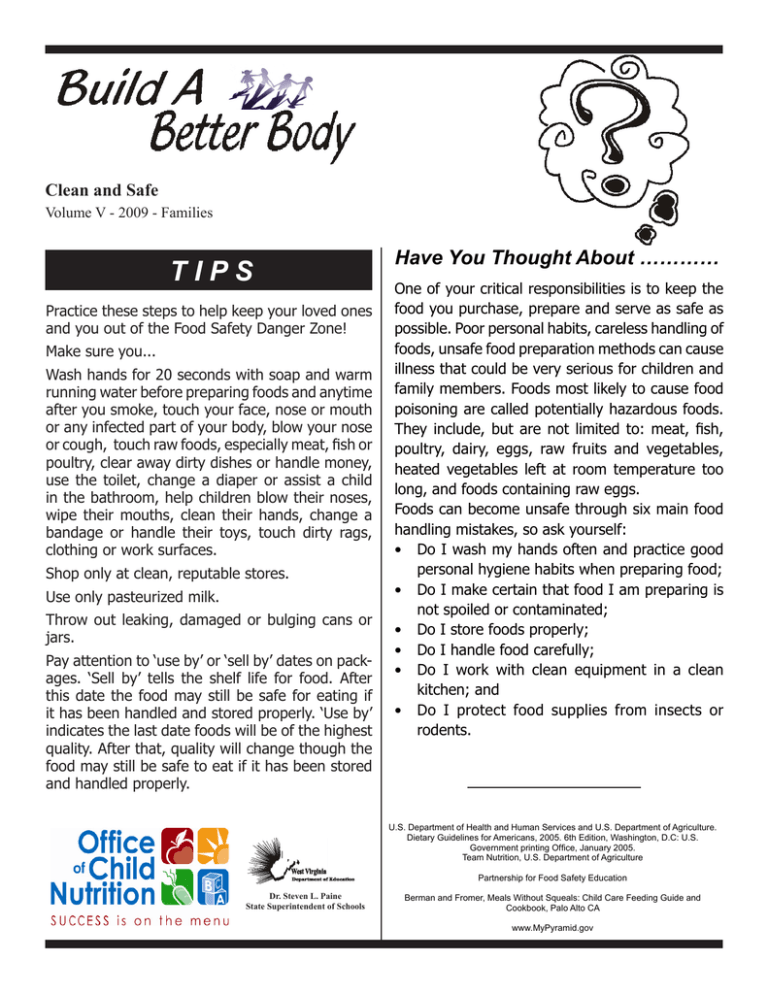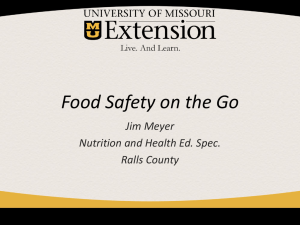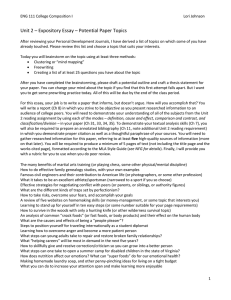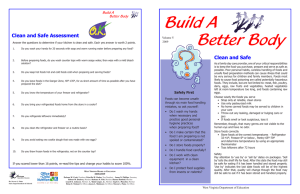T I P S Have You Thought About ………… Clean and Safe
advertisement

Clean and Safe Volume V - 2009 - Families TIPS Practice these steps to help keep your loved ones and you out of the Food Safety Danger Zone! Make sure you... Wash hands for 20 seconds with soap and warm running water before preparing foods and anytime after you smoke, touch your face, nose or mouth or any infected part of your body, blow your nose or cough, touch raw foods, especially meat, fish or poultry, clear away dirty dishes or handle money, use the toilet, change a diaper or assist a child in the bathroom, help children blow their noses, wipe their mouths, clean their hands, change a bandage or handle their toys, touch dirty rags, clothing or work surfaces. Shop only at clean, reputable stores. Use only pasteurized milk. Throw out leaking, damaged or bulging cans or jars. Pay attention to ‘use by’ or ‘sell by’ dates on packages. ‘Sell by’ tells the shelf life for food. After this date the food may still be safe for eating if it has been handled and stored properly. ‘Use by’ indicates the last date foods will be of the highest quality. After that, quality will change though the food may still be safe to eat if it has been stored and handled properly. Have You Thought About ………… One of your critical responsibilities is to keep the food you purchase, prepare and serve as safe as possible. Poor personal habits, careless handling of foods, unsafe food preparation methods can cause illness that could be very serious for children and family members. Foods most likely to cause food poisoning are called potentially hazardous foods. They include, but are not limited to: meat, fish, poultry, dairy, eggs, raw fruits and vegetables, heated vegetables left at room temperature too long, and foods containing raw eggs. Foods can become unsafe through six main food handling mistakes, so ask yourself: • Do I wash my hands often and practice good personal hygiene habits when preparing food; • Do I make certain that food I am preparing is not spoiled or contaminated; • Do I store foods properly; • Do I handle food carefully; • Do I work with clean equipment in a clean kitchen; and • Do I protect food supplies from insects or rodents. U.S. Department of Health and Human Services and U.S. Department of Agriculture. Dietary Guidelines for Americans, 2005. 6th Edition, Washington, D.C: U.S. Government printing Office, January 2005. Team Nutrition, U.S. Department of Agriculture Partnership for Food Safety Education Dr. Steven L. Paine State Superintendent of Schools Berman and Fromer, Meals Without Squeals: Child Care Feeding Guide and Cookbook, Palo Alto CA www.MyPyramid.gov T I P S (continued) ACTIVITY TOOL Toss food that smells or looks suspicious, but remember you can not smell or see germs. Avoid reusing single use containers for food storage. Examples could include cottage cheese containers, margarine tubs, sour cream containers, etc, because the chemicals in the plastic could get in the food. Store all raw foods, especially meats on the lower shelf of the refrigerator. Keep cooked foods close to the top to avoid mixing with raw food juices. Place meats in a bowl or tray when thawing to avoid dripping on other foods. Wash our Hands, Wash our Hands Demonstrate for the children how to correctly wash their hands for 20 seconds, singing the ABC song. Show them how to wash palms, backs of hands, in between fingers and nails carefully to remove dirt and germs. Invite them to dance and sing “Old MacDonald Had a Farm” as they get ready to eat. Wash fruits and veggies thoroughly, scrub if necessary, before serving, including bagged salad greens. Thaw foods completely in the refrigerator; never thaw foods on the counter or warm water. If you are going to prepare the food immediately, thaw in the microwave. Remember: Keeping foods safe takes knowledge and effort! NUTRITION TOOL! Yummy Fruit Salad Ingredients: Apple, washed and sliced Orange, washed, peeled and sliced Banana, peeled Berries or pear, washed and sliced 6oz Orange flavored yogurt Method: Assist children in washing their hands. Wash fruit, showing the children how to scrub fruit clean. Give each child a piece or portion of fruit along with a plastic serrated knife, clean plastic cutting board or plate. Let children slice fruit into bite size pieces and place in mixing bowl. Add flavored yogurt and mix gently. Chill for 30 minutes and serve as a snack. In accordance with federal law and U.S. Department of Agriculture (USDA) policy, this institution is prohibited from discriminating on the basis of race, color, national origin, sex, age, disability or retaliation. If you require information about this program, activity or facility in a language other than English, contact the USDA agency responsible for the program or activity, or any USDA office. If you require this information in alternative format (Braille, large print, audiotape, etc.) contact the USDA’s TARGET Center at (202) 720-2600 (Voice or TDD). To file a complaint of alleging discrimination, write: USDA, Director, Office of Civil Rights; 1400 Independence Avenue, S.W., Washington, D.C. 20250-9410, or call toll free (866) 632-9992 (Voice). TDD users can contact the USDA through local relay or the Federal Relay at (800) 877-8339 (TDD) or (866) 377-8642 (relay voice users). USDA is an equal opportunity provider and employer. West Virginia Board of Education 2008-2009 Delores W. Cook, President; Priscilla M. Haden, Vice President; Jenny N. Phillips, Secretary Robert W. Dunlevy, Member; Barbara N. Fish, Member; Burma Hatfield, Member; Lowell E. Johnson, Member; L. Wade Linger, Jr., Member; Gayle C. Manchin, Member Brian E. Noland, Ex Officio; James L. Skidmore, Ex Officio; Steven L. Paine, Ex Officio







